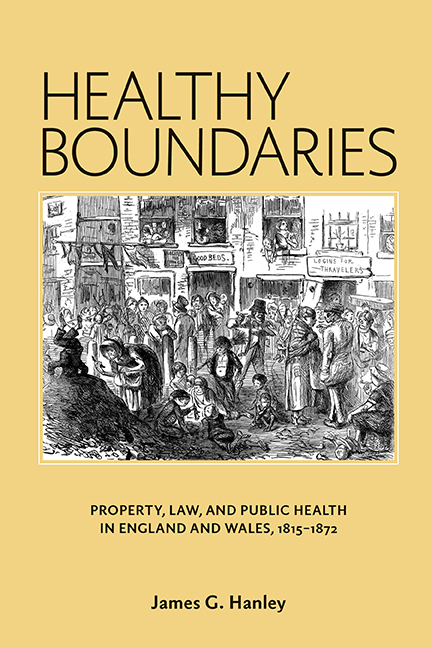Book contents
- Frontmatter
- Dedication
- Contents
- Acknowledgments
- Abbreviations
- Introduction
- 1 The Laws of Nuisance Before 1846: Property, Health, and Democracy in the Age of Reform
- 2 Private Benefit and Public Service: Paying for Sewers Before 1848
- 3 The Boundaries of Health, 1848–70
- 4 The Benefits of Health: London, 1848–65
- 5 Healthy Domesticity, 1848–72
- Conclusion
- Notes
- Bibliography
- Index
- Frontmatter
- Dedication
- Contents
- Acknowledgments
- Abbreviations
- Introduction
- 1 The Laws of Nuisance Before 1846: Property, Health, and Democracy in the Age of Reform
- 2 Private Benefit and Public Service: Paying for Sewers Before 1848
- 3 The Boundaries of Health, 1848–70
- 4 The Benefits of Health: London, 1848–65
- 5 Healthy Domesticity, 1848–72
- Conclusion
- Notes
- Bibliography
- Index
Summary
One of the defining features of nineteenth-century urban development in Britain was the growth of public health. The centrality of public health to modern urban life derives from the effects it had on mortality rates, but these effects do not exhaust its significance. As I have argued in this book, among the most important legacies of the early English and Welsh public health movement were the redefinitions of property it promoted. I have framed these redefinitions as a series of boundary shifts between healthy and unhealthy things, between public and private services, between taxable and nontaxable property, between cities and suburbs, and last, between healthy and unhealthy domesticity. Parliament and the courts permitted or sanctioned all of these boundary shifts, but they were largely driven, I stress, by provincial and metropolitan local authorities of one sort or another.
This interpretation suggests a revision in our ongoing revaluation of local authorities in this period. Their current somewhat unfavorable reputation rests on the slow rate of change in urban death rates and the incremental progress made in building sanitary works. Although both observations are correct, they may not tell the full story. Public health measures may well have contributed to the decline of some infectious diseases, even if overall mortality did not decline. And the record of sanitary works, if taken as a metric for evaluation, needs cautious interpretation. We need to take stock not only of how many nuisances local authorities abated, how many privies they converted into water closets, or how many miles of sewer they laid but also of the fact that there was even a category of nuisance to abate, that they controlled private domestic arrangements in any way, and that they were able to build healthy infrastructure on a financially sustainable and more equitable basis than in the past. Each of these activities required some readjustment of the salubrity, sanctity, and liability of property. In some cases, decades of legal labor were necessary to achieve it. All of these legal accomplishments mattered. They set the stage for the more rapid growth of healthy cities during the last quarter of the century.
- Type
- Chapter
- Information
- Healthy BoundariesProperty, Law, and Public Health in England and Wales, 1815–1872, pp. 132 - 136Publisher: Boydell & BrewerPrint publication year: 2016



